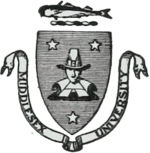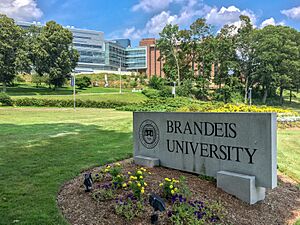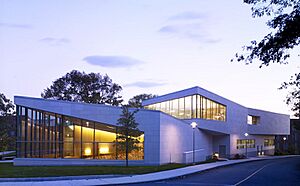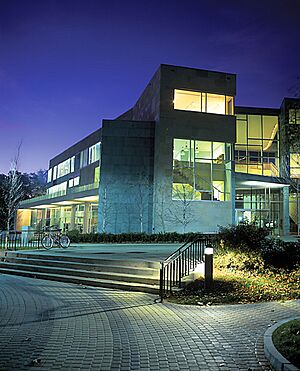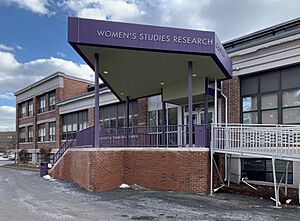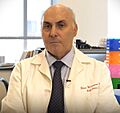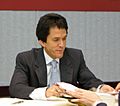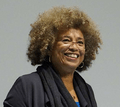Brandeis University facts for kids
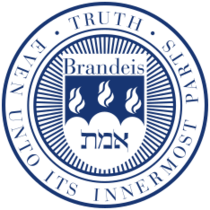 |
|
| Motto | Hebrew: אמת, romanized: Emet (Truth) |
|---|---|
|
Motto in English
|
"Truth even unto its innermost parts" |
| Type | Private research university |
| Established | October 20, 1948 |
| Accreditation | NECHE |
|
Academic affiliations
|
|
| Endowment | $1.26 billion (2024) |
| President | Arthur E. Levine |
| Provost | Carol Fierke |
|
Academic staff
|
559 (2023) |
|
Administrative staff
|
1,451 (2023) |
| Students | 5,302 (2023–24) |
| Undergraduates | 3,675 (2023–24) |
| Postgraduates | 1,627 (2023–24) |
| Location |
,
,
United States
42°21′56″N 71°15′35″W / 42.365664°N 71.259742°W |
| Campus | Small city, 235 acres (95 ha) |
| Newspaper |
|
| Colors | Blue |
| Nickname | Judges |
|
Sporting affiliations
|
|
| Mascot | The Judge and Ollie the Owl (named for Justice Oliver Wendell Holmes Jr.) |
 |
|
Brandeis University is a private research university in Waltham, Massachusetts, near Boston. It was founded in 1948 as a university open to students of all backgrounds and religions. The university is named after Louis Brandeis, who was a justice on the U.S. Supreme Court.
Brandeis is known as a top-level research university. This means students and professors work on important new discoveries. The university has been a member of the prestigious Association of American Universities (AAU) since 1985. In 2018, it had about 5,800 students on its 235 acres (95 ha) campus.
Many famous people have studied or taught at Brandeis. These include Nobel Prize winners like Drew Weissman, Michael Rosbash, and Roderick MacKinnon. The co-creators of the TV show Friends, David Crane and Marta Kauffman, also went to Brandeis.
Contents
History
How Brandeis University Began
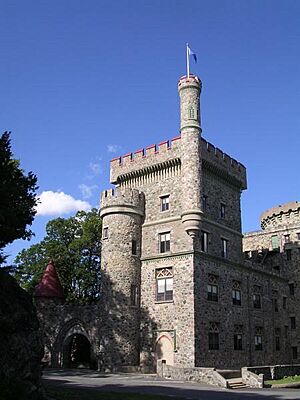
Brandeis University was built on the site of an older school called Middlesex University. Middlesex was a medical school that was important because it did not limit the number of Jewish students it accepted, which many other schools did at the time. But by 1944, the school was close to failing financially.
The founder's son, C. Ruggles Smith, looked for a way to save the campus. He found a group in New York, led by Israel Goldstein, that wanted to start a Jewish-sponsored university that would be open to everyone. Smith offered the Middlesex campus to Goldstein's group.
Goldstein was excited to get a large campus so close to Boston and New York City. He asked a Boston lawyer named George Alpert to help raise money. They formed The Albert Einstein Foundation for Higher Learning, Inc. to create the new school.
Getting Support from Albert Einstein
Albert Einstein's involvement brought a lot of attention to the new university. He believed the school could attract talented young people from all fields. The founders wanted to name the university after Einstein, but he declined. Instead, they named it after Louis Brandeis, a famous Supreme Court justice.
Einstein had some disagreements with the university's organizers. He wanted to make sure the school had very high academic standards. He eventually left the project in 1947. Despite these early challenges, the university moved forward.
Opening and Early Years
Brandeis University officially opened on October 14, 1948. The first class had 107 students from all over the world. They were taught by 13 professors. The campus was small at first. The library was in a barn, and students slept in old army buildings.
The university grew quickly. In 1949, former First Lady Eleanor Roosevelt joined the board of trustees. By 1952, the first class of 101 students graduated. The famous composer Leonard Bernstein planned a four-day arts festival to celebrate. His opera Trouble in Tahiti was performed for the first time at the event.
In 1954, Brandeis began building three separate chapels for Catholic, Protestant, and Jewish students. This showed the university's commitment to welcoming people of all faiths. A nine-foot bronze statue of Louis Brandeis was added to the campus in 1956 and is now a famous landmark.
The university decided to stop its football program in 1960 to focus on other sports and academic programs.
A Center for Student Activism
During the 1960s, Brandeis became a center for student activism. Many students protested against the Vietnam War.
In 1969, a group of about 70 Black students peacefully took over a student building called Ford Hall. They demanded that the university hire more Black professors and accept more Black students. The protest lasted for eleven days. In the end, the university agreed to many of the students' demands and created a department for African American studies.
Recent History
In the 21st century, Brandeis has continued to be an important center for learning and discussion. It has hosted famous speakers like former presidents Bill Clinton and Jimmy Carter.
Like many universities, Brandeis has faced challenges. In 2009, after a major financial crisis, the university considered closing its Rose Art Museum. However, after many people protested, the museum remained open.
In 2014, the university planned to give an honorary degree to Ayaan Hirsi Ali, a supporter of women's rights. However, some of her past statements caused disagreement on campus. After discussions, the university decided to withdraw the offer. This event started a big conversation about free speech at universities.
Campus Life
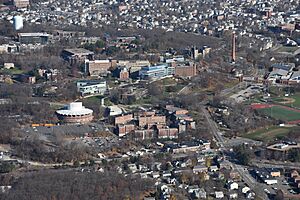
The Brandeis campus is a busy place with many different schools and research centers.
- The College of Arts and Sciences is the main undergraduate school.
- The Graduate School of Arts and Sciences offers advanced degrees like master's degrees and PhDs.
- The Heller School for Social Policy and Management focuses on solving social problems.
- Brandeis International Business School teaches students about global business and finance.
The campus also has the Rose Art Museum, which features modern and contemporary art. The Brandeis Library has over 1.5 million books and gives students access to many online resources.
Academics and Reputation
| ARWU World | 301–400 |
|---|---|
| THES World | 251–300 |
| USNWR National University | 63 |
| Washington Monthly National University | 119 |
| Forbes | 105 |
Brandeis is considered a highly-ranked university. U.S. News & World Report ranked it 63rd among national universities in 2024. It is known for being very selective, meaning it is difficult to get accepted.
Some of its programs are ranked among the best in the world. For example, its business school was ranked #1 by the Financial Times for its master's program in international economics for several years.
Research Centers
Brandeis is home to many special research centers.
- The Cohen Center for Modern Jewish Studies was the first academic center in the U.S. for studying modern Jewish life.
- The Steinhardt Social Research Institute studies data about religion and different ethnic groups in the U.S.
- The Women's Studies Research Center supports scholars from around the world who study gender.
Student Activities
Brandeis has over 270 student-run clubs and organizations. These include 11 a cappella singing groups, several theater companies, and comedy troupes.
A popular spot on campus is Cholmondeley's, a coffeehouse located in an old castle building. It's known as "Chums" and hosts concerts and student performances. Famous musicians like Bob Dylan and Tracy Chapman have performed there.
Students can also get involved in many activism groups that work on issues like protecting the environment, feminism, and human rights.
Athletics
Brandeis sports teams are called the Judges. They compete in NCAA Division III sports. The university has 19 varsity teams.
The men's soccer team won a national championship in 1976, and the men's cross country team won in 1983. In recent years, the basketball and soccer teams have been ranked among the top 10 in the nation.
Notable People
Many Brandeis graduates and faculty have become famous in their fields.
-
Roderick MacKinnon (BA, 1978) Winner of the Nobel Prize in Chemistry in 2003
-
Drew Weissman (BA, MA, 1981) Winner of the Nobel Prize in Physiology or Medicine in 2023
-
Edward Witten (BA, 1971) Famous physicist and Fields Medal winner
-
Leslie Lamport (PhD, 1972) Turing Award–winning computer scientist
-
Karen Uhlenbeck (PhD, 1968) The first woman to win the Abel Prize in Mathematics
-
Eve Marder (BA, 1965) Winner of the Kavli Prize in Neuroscience
-
Robert Zimmer (BA, 1968) Mathematician and former president of the University of Chicago
-
Thomas Friedman (BA, 1975) Three-time Pulitzer Prize winner
-
Margo Jefferson (BA, 1970) Pulitzer Prize for Criticism winner
-
Angela Davis (BA, 1965) Political activist, philosopher, and author
-
Debra Messing (BA, 1990) Emmy Award–winning actress
Graduates include political activists Abbie Hoffman and Angela Davis, journalist Thomas Friedman, and actresses Debra Messing and Loretta Devine. Author Mitch Albom, who wrote Tuesdays with Morrie, also graduated from Brandeis.
Famous faculty members have included composer Leonard Bernstein, psychologist Abraham Maslow, and former First Lady Eleanor Roosevelt. Sociologist Morrie Schwartz, who was the subject of Tuesdays with Morrie, was also a professor at Brandeis.
Images for kids
See also
 In Spanish: Universidad Brandeis para niños
In Spanish: Universidad Brandeis para niños
- List of Brandeis University people
- National Center for Jewish Film
- Rosenstiel Award


